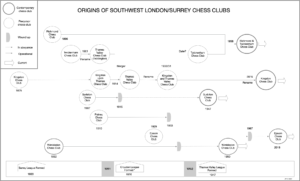
Formations, mergers and renaming
We may identify three themes in the onomatology of Kingston Chess Club: formations, mergers and renaming. The formation of a chess club can take place more than once. Just one or two well-organised individuals can set up a club and keep it running for decades. When they pass on, the club may be wound up and go into abeyance until, perhaps decades later, another enthusiast appears on the scene who may resurrect a chess club with the same name as its precursor. In this sense, we may regard chess clubs as having a continual identity. Even if clubs were already established in small neighbourhoods such as Twickenham or Teddington, inevitably the larger populated centres such as Kingston would demand their own chess centre.
Clubs comprised a common-interest social group, meeting at least once a week and usually more often. The number of members did not change very much from one year to the next. Before leagues became the dominant mode of play, with the associated grading system, chess was a more leisurely affair. Players did not necessarily use clocks; smoking was profuse; drinking – and sometimes also eating – was part of the package. There were hardly any chess books in English. Occasionally, the club had to move from its venue, in which case the players may, in the case of the major cities, have relocated to another club nearby. The two main reasons for moving were the loss of key organisers and the number of members being insufficient to support the modest financial requirements of the club.
When two clubs merged, the name of the club may have been changed, depending on the relative contribution of the clubs. In 1914, the Thames Valley Chess Club, which was based in Teddington, took over the club based in Kingston upon Thames. It may be that players from Teddington were prepared to play in Kingston if the name of their club could come with them. This arrangement proved satisfactory for 16 years until other factors led the club to rename itself Kingston & Thames Valley Chess Club. This may have been to recognise the previous name of the club, which had been lost in the merger. The club name was finally changed to Kingston Chess Club in 2015.